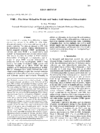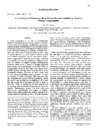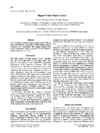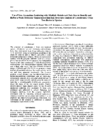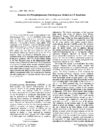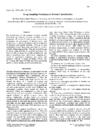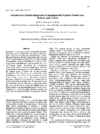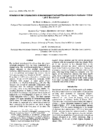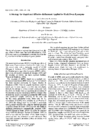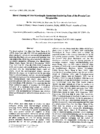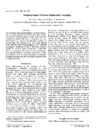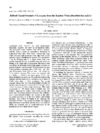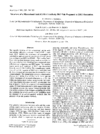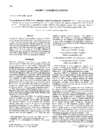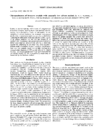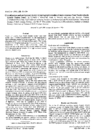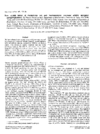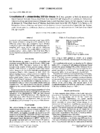issue contents
May 1995 issue

Cover illustration: Active site of purine nucleoside phosphorylase with the electrostatic potential surface and dipole of guanine. Rendered with Ribbons++ and SPARTAN.
lead articles
The NMR method for three-dimensional structure determination of biological macromolecules in solution is reviewed, with special emphasis on the complementary roles of NMR and X-ray crystallography in structural biology.
topical reviews
To crystallize a protein it is important to stabilize it against denaturation and it may be necessary to suppress its conformational flexibility. Compounds with general structure-stabilizing and conformational flexibility suppressing effects on protein structure have been described in the biochemical literature for many years. The recent successful use of these compounds in the crystallization of a number of proteins validates the idea that these compounds will be generally useful in protein crystallization.
research papers
Lysozyme single crystals were grown with their shape controlled by the cylindrical capillary used as a growth cell. The shaped crystals were shown to diffract up to 1.74 Å.
Crystal structures of two bacterial cytochromes c' have been determined. Molecular replacement gave no clear results, but the correct solution was identified and partially refined with the help of the iron anomalous scattering.
The X-ray structure of sheep liver 6-phosphogluconate dehydrogenase apoenzyme, refined at 2 Å resolution, shows the molecule to have an extended dimer interface, including a water network, in which the C-terminal domain of one subunit is incorporated within the second. The subunit contains a duplicated five-helix bundle unique to this enzyme; and a dinucleotide-binding fingerprint with an alanine in place of the second conserved glycine.
Protein crystallization can be approached by, sampling techniques. An automatic and re-iterative procedure has been developed for this purpose
Myotoxin 11 shows a novel dimeric form in which the proposed active-site entrance is exposed to solvent.
PDB reference: 1clp
The trigonal structure of oxidized flavodoxin from Anabena 7120 has been solved at 1.40 A resolution and refined to an R factor of 13.91%. The paper describes details of the structure including water structure, FMN conformation and disorder of some amino-acid residues.
PDB reference: 1rcf
The crystal structure of a goose-type lysozyme from the egg white of black swan has been determined at 1.9 Å resolution using a semi-automatic procedure based on the C α coordinates of the homologous goose protein.
Recombinant trypanothione reductase from Crithidia fasciculata is produced and used to grow crystals which diffract to 1.4 Å resolution. For optimal crystal growth, a novel plug drop geometry is developed.
A combination of direct methods, solvent flattening, local symmetry averaging and skeletonization has been proved capable of solving the protein structure of core streptavidin from one-wavelength anomalous-scattering X-ray data.
Reciprocal-space averaging of non-crystallographically equivalent electron density has been successfully tested for the phase refinement of a bacteriophage. The advantages and disadvantages of reciprocal versus real-space averaging are discussed.
Our structure study shows that the rainbow trout lysozyme is a typical c-type lysozyme and we suggest that its high activity at low temperature is a consequence of greater flexibility in loop regions.
PDB reference: 1lmn
3 Å resolution refinement of this Rhodobacter sphaeroides wild-type reaction center reveals an Mn2+-binding site identical to that of Fe2+ in other reaction centers. The structure is highly homologous to that of Rhodopseudomonas viridis except for the carotenoid (spheroidene) conformation which is a non-planar 15-l5'-cis isomer.
The crystal structure of R6.5 antibody, a therapeutic anti-inflammatory and anti-HRV agent, has been solved by the molecular-replacement method and refined.
PDB reference: 1rmf
short communications
Crystals of P. mevalonii HMG-CoA reductase have been produced in the cubic space group I4132. Manipulations of buffer glycerol content and microseeding techniques are described which led to large (> 1.0 mm) X-ray quality crystals.
Low-humidity monoclinic lysozyme crystals with solvent contents of 17.6, 16.9 and 9.4% have been characterized. They would permit the study of the enzyme at different levels of hydration.
Crystals of salmon pancreatic elastase have been obtained by the vapour-diffusion technique. The crystals diffract to 1.6 Å resolution and belong to the tetragonal space group P41212 or P43212.
The extremely thermostable glutamate dehydrogenase for Pyrococcus woesei was crystallized. The crystallographic parameters as well as the local symmetry of the hexameric molecule were determined.
New crystal forms of Escherichia coli and Saccharomyces cerevisiae soluble inorganic pyrophosphatase are described that diffract to a higher resolution than any forms reported previously.
Diffraction-quality crystals of a calcium-binding EGF-like domain from the blood clotting factor IX have been obtained. These crystals were grown in sitting drops (on polypropylene supports to avoid adhesion), by vapour-diffusion driven dehydration.
books received
Free 



 journal menu
journal menu









